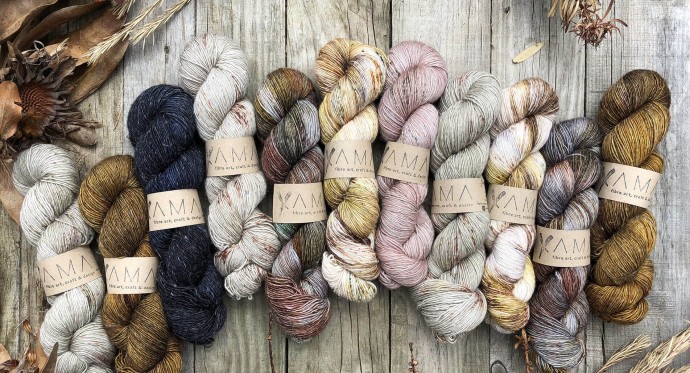Exploring Knitting Yarn – Part 2: Types and How to Choose It
This post is the second part of my series of posts about the basics of knitting yarns. Last time we talked about the most common yarn fibers, and here I would like to share with you a brief overview of another selection of yarn types, including merino wool, organic yarn, hemp yarn, mohair, novelty and linen.
Merino Wool
Taken from the merino sheep, this yarn is super soft and doesn't cause allergic reactions as regular wool does. Blocks very nicely but can "pill" (create little fuzz balls). If you get the chance to work with merino wool, do it.
Organic Yarn
Organic yarn is produced from wool free from chemicals. Sourced from sheep with no synthetic inputs. The livestock have not been through dips, drenches, back lining or antibiotics. Cleaning process of Organic wool yarns includes using only hot water and detergent. Many organic yarns are from the Merino Sheep. This wool is excellent for winter knitted garments.
Hemp Yarn
Hemp, a relative newcomer to the knitting world is a delightful natural fiber. Hemp is surprisingly soft to the touch. It’s hard wearing and has great stitch definition. Most commonly known for its use in macrame.
Perfect for: sweaters, bags, spa accessories & home decor projects due to its superior strength and durability.
Bamboo Yarn
Bamboo is a natural fiber. It is soft, light and environmentally friendly! It wears well and is often considered to have natural antibacterial properties. It feels very soft and has a wonderful drape. Bamboo can be softer than silk when spun into yarn.
Perfect for: Knitted garments that need drape. As bamboo yarn is quite breathable and cool it’s perfect for summer tops and sweaters.
Mohair Yarn
Mohair, known as the “diamond fiber” has a halo of lustrous fibers that surround the yarn, which creates silky soft stitches that are warm yet remarkably light weight. This type of yarn is made from the wool of Angora goats. Mohair yarns can be knit alone to create light, airy fabrics or held with any other yarn to add softness, subtle color & a luscious halo. It is also great for bulking up thinner yarns. Mohair has excellent insulating and moisture evaporation properties. It is a season all-rounder.
Novelty Yarn
Novelty Yarn comes in a variety of colors and textures and add interest to a knitted garment. Made of synthetic fibers these yarn blends, novelty yarns provide texture and interest. Novelty yarns give fabrics interesting and decorative surface effects, and the textile designers can create fabric with raised or nubby surface textures as distinguished from the usual flat surface of most textile materials by using novelty yarns, which enhance the beauty of a fabric at low cost.
Perfect for: Great for adding interest and texture to your knitted projects. Novelty yarns like spike yarns are being used in making soft toys. These yarns are providing us with a huge variety of surface ornamented fabrics.
Linen
Linen fabric is made from the cellulose fibers that grow inside the stalks of the flax plant, one of the oldest cultivated plants in human history.
It is the most glorious fiber of all! Made from the long, straight fibers of the flax plant’s stem, linen is cool and drapey. If you have never worked with an inelastic fiber though, linen can feel pretty different the first time you try it. Linen yarn doesn’t conform to the needles the way that wool does, so it creates a slightly larger stitch. In response, many knitters tension the yarn tightly, trying to achieve the same size stitches they’d get with wool. Don’t. Ease up, and go down a needle size or two. You’ll probably need to use a much smaller needle than you would for wool, but it will ultimately be a more pleasant experience.
Perfect for: warm-weather garments.
Now that you know all about the types of yarn fiber, you can make better decisions on yarn for your projects. Is it a garment to be worn for years? Maybe wool would be an ideal choice! Are you making a toy for a child? Well then acrylic yarn that can be washed often might be the way to go. If you haven’t ventured beyond the acrylic yarn available at the chain stores, I encourage you to check out a local yarn shop to try some other types of yarn fiber unfamiliar to you.

